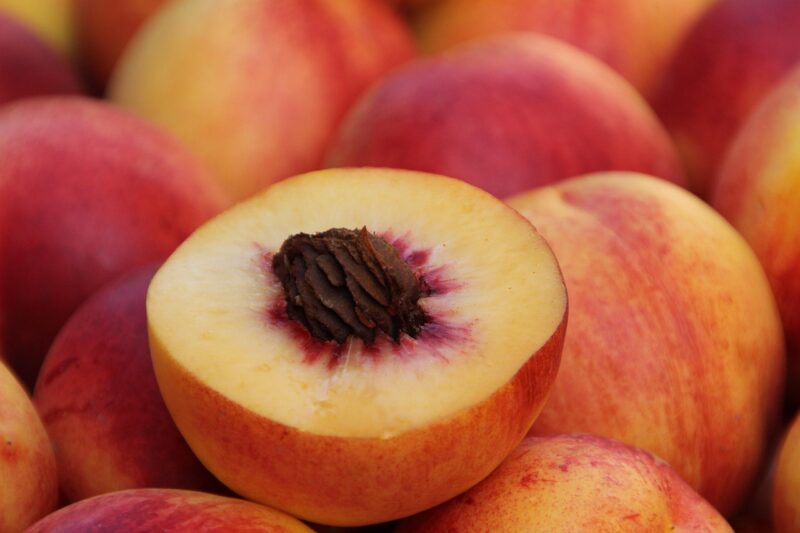Peaches represent the sweet embrace of summer, evoking memories of sun-drenched afternoons and lazy picnics. Their juicy flesh and fragrant aroma are joys that many of us look forward to annually. However, when the season’s end approaches, the thought of bidding farewell to fresh peaches can be disheartening.
The good news is that with a bit of effort and some helpful techniques, you can preserve those luscious fruits and savor their taste throughout the year. Whether you are a seasoned canner or a novice, this guide will help you understand the nuances of peach preservation.
Selecting the Perfect Peaches

The foundation of successful preservation starts with selecting high-quality peaches. When you’re at the market or standing in your orchard, look for peaches that have a vibrant color and feel slightly soft to the touch. Imperfections or bruising can indicate over-ripeness or beginning spoilage. Remember, your goal is to choose peaches that are ripe but still firm enough to maintain their structure during the preservation process.
Additionally, consider the scent. A ripe peach exudes a rich, sweet fragrance—a sign of perfect ripeness. To enhance your preservation experience, think about the variety you choose. Some popular varieties include the juicy Georgia Peach and the sweet Donut Peach. Each type has a unique flavor profile that can shine through in your preserved dish, so it pays to consider what you’ll eventually be using them for.
Preparing Peaches for Preservation
Before you can preserve peaches, they need to be prepared properly. Here’s a step-by-step guide that embraces a combination of tradition and practicality.
Cleaning and Peeling
Wash: Start by washing each peach under cool, running water. This step removes any dirt or pesticides that might linger.
Peeling: Many preservation methods benefit from skin removal, especially if you’re canning or making preserves. The easiest way to peel peaches is to blanch them. Fill a pot with boiling water and prepare a bowl with ice water.
Submerge the peaches in boiling water for about 30 seconds.
Immediately transfer them to the ice water. This shocks the fruit, making the skins slip off easily.
Keep a sharp knife handy for any stubborn spots. After peeling, slice the peaches in half, discard the pits, and either slice or cube the flesh as needed.
Preparing for Preservation Methods
For Freezing: Toss the peach slices with a bit of lemon juice to prevent browning and pack them into freezer bags or airtight containers. Make sure to leave some space for expansion when freezing.
For Canning: Prepare a syrup or juice solution to pack the peaches in. You can create a sugar syrup by heating water and sugar (to taste), or use natural peach juice for a healthier alternative. Fill sterilized jars with peaches and cover them with your chosen syrup.
For Jams and Jellies: Chop the peaches, add sugar, and cook down with pectin to create a delightfully sweet spread. A touch of lemon juice not only enhances flavor but also helps with preservation.
Freezing Peaches: A Friendly and Flexible Option

Freezing is one of the simplest and most effective ways to preserve peaches. It’s user-friendly and maintains most of the fruit’s nutritional value and flavor.
Step-by-Step Freezing Process
Prepare Peaches: As mentioned earlier, wash and peel the peaches. Slice them into your desired thickness.
Prevent Browning: Toss the slices in lemon juice or a specific anti-darkening solution to keep them looking fresh.
Pre-Freeze Technique: Spread the peach slices out in a single layer on a baking sheet. This method ensures they freeze individually, making it easier to use only what you need later.
Pack and Store: Once frozen solid, transfer the slices into labeled freezer bags, expelling excess air before sealing. This technique helps to maintain freshness for up to a year.
Using Frozen Peaches: Whether you’re tossing them in smoothies, baking them into pies, or just enjoying them as a frozen treat, there’s no limit to how these vibrant pieces of summer can be integrated into your monthly menu.
Canning Peaches: An Art and a Science

Canning is a time-honored method of food preservation, transforming fruits into delicious treats you can enjoy year-round. While the process may seem daunting at first, the principles of canning are straightforward and rewarding.
Understanding the Canning Process
To can peaches, you’ll use a method called water bath canning. This technique is essential for fruits, as it relies on heat to seal jars and maintain food safety.
Gather Your Equipment: You’ll need a water bath canner, large pots, sterilized jars, new lids, and canning utensils.
Prepare Jars: Sterilize the jars by boiling them in water for 10 minutes or running them through the dishwasher on a hot cycle before filling.
Cook the Peaches: Prepare your syrup or juice, then heat the peach slices gently in the syrup to soften them slightly before packing.
Fill Jars: Place peach slices into each jar, packing them tightly but leaving some headspace. Pour the hot syrup or juice over the peaches until it reaches the headspace mark.
Seal and Process: Wipe the rims of the jars to ensure a good seal. Place the lids on, then send the jars into the water bath canner for approximately 30 minutes. Make sure the water covers the jars by at least an inch.
Post-Canning Care
After processing, allow the jars to cool at room temperature for 12 to 24 hours. Check the seals; if the center of the lid is slightly concave and doesn’t pop back when pressed, it’s sealed properly. Labeled jars can be stored in a cool, dark place for up to a year. The sweet reward of your labor will be felt when you crack open a jar and find summer’s bounty within.
Making Peach Preserves, Jams, and Jellies
If you’re looking for another dimension to peach preservation, consider making jams or preserves. These delightful spreads are not only easy to prepare, but they also allow you to experiment with flavors and textures.
The Differences Between Preserves, Jams, and Jellies
While the terms may seem interchangeable, they do carry distinct characteristics.
Peach Jam: A smooth blend of peach pulp, sugar, and pectin, resulting in a spreadable consistency.
Peach Preserves: Offers chunks of fruit within a syrupy base, perfect for when you want a little more texture.
Peach Jelly: Made solely from the juice of the peaches, creating a clear gel-like spread.
Crafting Your Preserves
Select Ripe Peaches: Use fully ripe, flavorful peaches for the best result.
Combine Ingredients: For a basic peach jam, combine 4 cups of chopped peaches with 5 cups of sugar and 1 box of pectin in a large pot.
Cook: Bring the mixture to a rolling boil, stirring constantly. Allow it to boil for about 10 minutes until it thickens.
Test for Consistency: You can check if it’s set by placing a spoonful onto a cold plate. If it holds its shape after cooling, it’s ready for jarring.
Jar and Seal: Follow the same steps for canning to ensure your jars are sealed effectively.
Exploring Non-Traditional Preservation Methods
While canning and freezing are the most traditional methods of preserving peaches, several innovative approaches can impart unique flavors and preserve the fruit’s integrity.
Dehydrating Peaches

Dehydrating peaches is an excellent way to create a shelf-stable snack that captures the essence of summer without added sugars or preservatives.
Preparation: Start with washed and peeled peaches. Slice them evenly to ensure even drying.
Dehydrator vs. Oven: You can use a food dehydrator or an oven set on low heat. If using an oven, place the peaches on a parchment-lined baking sheet.
Drying: If using a dehydrator, follow the manufacturer’s instructions; typically, it might take around 8-12 hours at 135°F. If using an oven, it can take around 6-8 hours at its lowest setting, turning the peaches occasionally.
Storage: Once dried, store your peach slices in an airtight container. They can last for months and provide a sweet snack whenever you crave a taste of summer.
Peach Sauces and Butters
Turning peaches into sauces or butters adds versatility. These can be used as toppings or ingredients in various recipes.
Peach Sauce: Cook down peaches with sugar, lemon juice, and spices until they reach a saucy consistency. This prepared sauce is perfect for ice cream or pancakes.
Peach Butter: For a silky, creamy treat, puree cooked peaches with sugar and spices, then cook slowly until thickened. Both are typically canned or frozen for future use.
Tips for Long-Term Preservation Success
Preserving peaches, like any food preservation endeavor, comes with its challenges. Here are some practical tips to make your experience smoother and more successful.
Practice Good Hygiene: Always wash your hands and surfaces before you begin. Clean equipment prevents spoilage and promotes quality preservation.
Check Sugar Levels: If you’re sugar-conscious, feel free to adjust recipes, but understand the role sugar plays in preservation. Natural sweeteners can often be substituted, but results may vary.
Label and Date Everything: Whether freezing, canning, or drying, make sure you label containers with the contents and date. This practice helps to maintain inventory and track which peaches should be used first.
Experiment and Adapt: Don’t be afraid to try new recipes or preservation methods. The peach preserves you create can be further flavored with herbs like basil or spices like ginger.
Beyond Preservation: Creative Uses for Peaches
Once you’ve preserved peaches, it’s exciting to think of the myriad of ways you can use them. Think beyond the simple jar; integrate preserved peaches into your daily life.
Culinary Creations
From cobblers to salads, the versatility of preserved peaches is remarkable. Incorporate them into your morning oatmeal, blend them into smoothies, or even serve them grilled with a scoop of vanilla ice cream for a delectable dessert.
Gifting Preserved Peaches
Homemade preserves make thoughtful gifts. Present them in decorative jars, perhaps with a handwritten label or a complementary recipe. It’s a heartfelt gesture that shares your love for both the fruit and the craft of preservation.
Creating a Peach-Themed Meal
If you’re feeling ambitious, plan an entire meal around delightful peach flavors. Start with a peach salad, followed by roasted chicken glazed with peach sauce, and finish with a peach pie. The sweet and savory interplay will surely impress your guests.
Reflections on the Art of Preservation
Engaging in the process of preserving peaches offers not only practical benefits but also a chance for introspection and appreciation. The act of transforming seasonal fruit into long-lasting delights serves as a reminder of the cycles of nature, the labor of our hands, and the joy of harvest.
Each jar filled with peaches represents a moment in time—a slice of summer that can be savored even in the depths of winter. The relationships built around such food processes—sharing recipes, exchanging fruit, or even passing down preserving secrets—forge connections that last well beyond the dining table.
Conclusion
Preserving peaches isn’t just about extending the lifespan of a delectable fruit; it’s about crafting memories, embracing sustainability, and celebrating the bounties of the earth. With the methods outlined here, whether you choose freezing, canning, or a more inventive approach, you can enjoy the essence of summer peach harvests long into the colder months.








